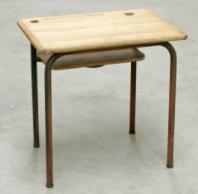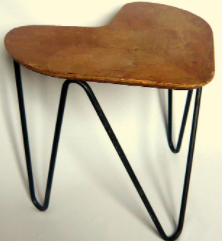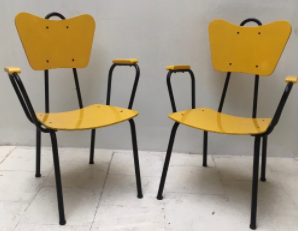Jacques Hitier (28 March 1917 – 5 March 1999) was a French interior architect and designer. Director of the Paris L’École Boulle, School for Fine Arts and Crafts, he has been described as one of the most prominent figures of decorative art.

Image source: http://www.librairie7l.com/jacques-hitier-modernite-industrielle-pierre-gencey-book.php
After the Second World War, he specialized in designing industrial furniture for public environments such as schools and government buildings. He showed all his artwork at Salon des Artistes Décorateurs and at Salon des Arts Ménagers. Hitier also designed more upscale and high-end home furnishings.
The Life of the Iconic Post-War French Designer
Jacques was born in Paris in 1917 and at the early age of 13, he was accepted into the renowned École Boulle. Graduating in 1934, he continued to live in Paris, working for the famed manufacturer Primavera of Printemps stores. In 1939, he was hired by Mobilor as a designer to direct the company’s design and production of school furniture.
After the war and with 2 years experience of working as a designer for the National Bank of Commerce, he set up his own design agency. This coincided with his first involvement in some major design exhibitions such as the Salon des Artistes Décorateur in 1949, under the direction of Jacques Adnet.
His stylish and practical school furniture became highly regarded within the design community and it was not long before the manufacturer Tubauto decided to recruit him as a designer for creating tubular metal furniture for the home. He teamed up with Tubauto for 15 years and the collaboration spawned many new models of furniture. At that time, this kind of association between a designer and a manufacturer was unique.
Throughout his life, Jacques Hitier was always driven by the wish of sharing his knowledge with aspiring young designers. This is shown by his relationship with the École Boulle of which he was a Specialized Teacher (1946-1964), Academic Dean (1964-1972) and subsequently Director (1972-1982).

Image source:
Jacques Hitier’s Career and Aesthetic
The first models of Jacques Hitier were produced by Mobilor in 1939, these early designs already showed his hallmark tubular metal frame style. For Mobilor, he also designed an earlier model of the popular Mullca 300 school chair.
In addition to his work with Tubauto, he also worked with other mass furniture producers such as MBO, La Méridienne, Multiplex, Durand, Glaces Marly and Crozatier. He made a personal signature out of tubular metal frame with soft materials such as wood, fabric, and rattan. He also made an impact on the evolution of design as a trade. He believed that the trade of a designer had changed greatly since the end of the War, and so he undertook some changes in the major designer confederation, called the Société des artistes décorateurs (SAD) which dated back to the Art Deco movement. In 1961, he refocused this confederation into Interior architecture matters.
He also created the union Créateurs d’Architecture d’Intérieur et de Modèles (CAIM) which he headed-up from 1962 to 1969.

Image source: https://www.wikiwand.com/en/Jacques_Hitier
Which are Hitier’s Most Famous Works?
Jacques Hitier produced many designs, among which: bedside tables, mirrors, chairs and lounge chairs, nightstands, bar carts, desks, coffee tables, and a camping set.
He also designed several pieces of furniture with a special focus on school environments, such as the famous School chair and a desk known as the Model Ètudiant Suspended. These works, as well as the majority of Hitier production, are realized in wood and tubular metal bent to form different frames.
Two of his most successful works are the Coffee Table No 34 and the Mullca 300, better known simply as the School Chair.
The first, a round coffee table, features a top in oak-veneered plywood over a tubular black-lacquered metal base. It is the perfect example of how Hitier, together with Tubauto, created a style in which the tube becomes the decor.

Image source: https://www.wikiwand.com/en/Jacques_Hitier
Made in 1949, Hitier’s Mullca 300 is a little vintage nursery school chair. The seat is made of plywood and its back, a tubular structure painted in green, extends to serve as armrests. The Mobilor company also produced a very similar model, equally designed by Jaques Hitier. Both models are often misattributed to the French designer Marcel Gascoin.

Image source: https://www.vntg.com/152277/set-of-2-chairs-by-jacques-hitier-for-tubauto/
Info sources:
